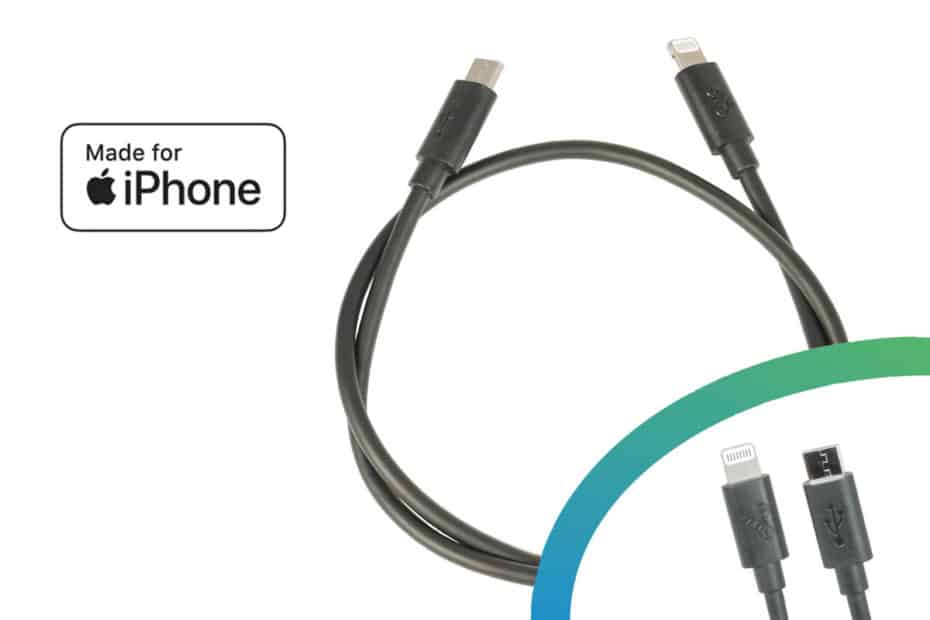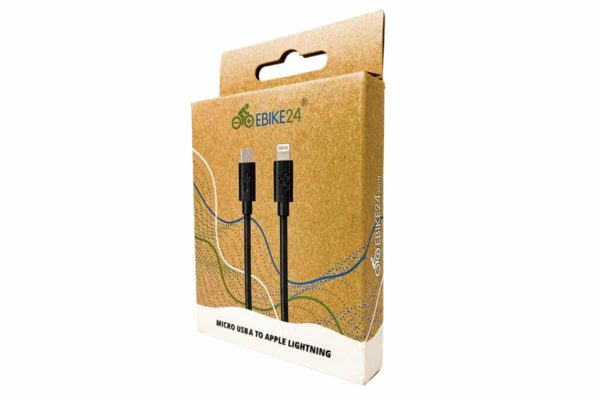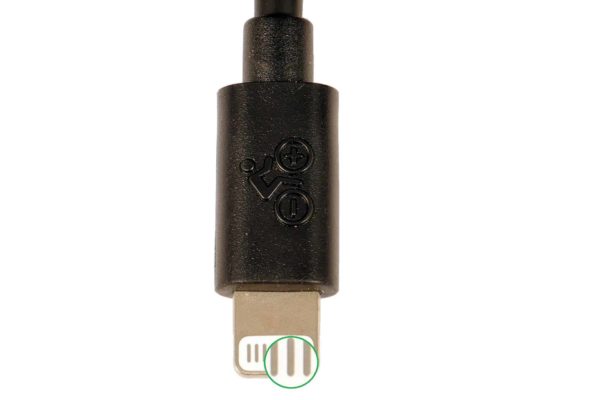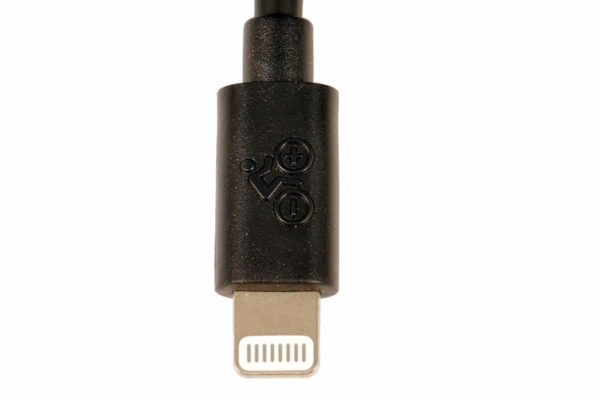Especially on longer tours with the ebike, it can be an advantage to be able to charge your iPhone or another mobile device from Apple via the display. The e-drive produces more than enough power for this. This way it doesn’t matter if you forget to check how much power is left in your smartphone battery when you start your ride. To ensure that charging always works without any worries, there are a few reasons why you should use an original Apple cable.
1. Which Bosch displays can be used to charge an iPhone?
2. What does the abbreviation MFi stand for?
3. What properties result from the MFi standard?
4. How does MFi certification work?
5. How can I recognise an MFi-certified charging cable?
6. How long should a suitable charging cable be?
7. Is Apple Lightning about to phase out?
1. Which Bosch displays can be used to charge an iPhone?
In the case of ebikes with a Bosch drive, the decision for or against the original is primarily relevant in those cases in which the bicycle manufacturer has installed one of the older systems. This means that basically six systems can be considered:
- Bosch Active Line
- Bosch Active Line Plus
- Bosch Performance Line
- Bosch Performance Line CX
- Bosch Performance Line Speed
- Bosch Cargo Line
The deciding factor for whether an iPhone can be charged at all, however, is the built-in display. Charging only works with one of the following three:
- Bosch Intuvia
- Bosch Kiox
- Bosch Nyon
In the case of the Bosch Nyon, only the model commonly referred to as Nyon 1 is meant. With the Nyon 2, which came onto the market for the 2020 season, Bosch unfortunately dropped the output of a charging current.
Nevertheless, there are a few variants for connecting a smartphone directly to the Bosch display and charging it in this way. Anyone who rides an ebike with a Smart System might be a little envious at this point. With the introduction of its latest drive, Bosch has changed its concept for charging mobile devices on the ebike. None of the displays available so far have a corresponding charging port. Only the Bosch SmartphoneGrip offers the option of charging – both inductively and classically via cable. For example, if you have an iPhone7 or an even older model, you can use an original USB charging cable with the Micro A to Apple Lightning connector.
2. What does the abbreviation MFi stand for?
In our opinion, the safest way to charge is with an original cable. Firstly, this refers to cables that come directly from Apple and are included with an iPhone, for example. Secondly, they include cables with MFi certification. The abbreviation Mfi stands for “Made for iPod/iPhone/iPad”. It identifies various accessories that are fully compatible with Apple mobile devices. The company introduced the standard in 2005. It wants to clearly distinguish itself from counterfeits and cheaper, technically inferior imitations by means of the associated logo.
3. What properties result from the MFi standard?
The central component of the Mfi standard is a special chip manufactured exclusively by Apple. It authenticates the accessories you connect to the Apple device. Your iPhone therefore classifies the charging cable as safe. If you use an uncertified one, on the other hand, you may receive a warning that the accessory is not supported. More annoying than the message is probably the charging process, which either does not start at all or runs extremely slowly.
Functions such as fast charging are tied to the MFi chip. It also protects the Apple device from overcurrent and overvoltage during charging. The inside of the charging cable is made of a copper core, which increases heat resistance. Using other cables with faulty connectors, on the other hand, can cause overheating.
In addition, Mfi-certified cables have a high-quality sheathing and improved bend protection. With such robustness, they usually last much longer than cheaper products. With them, you are spared the hassle of a plug that breaks off or gets stuck when you pull it out of the device. They also perform other tasks such as synchronising or transferring data with other devices just as reliably.
4. How does MFi certification work?
Apple uses a proprietary testing programme to certify its accessories. It tests selected safety and performance parameters. Only after successfully passing the test do products receive MFi certification. This is done directly by Apple or alternatively by an accredited laboratory.
Companies that have already violated Apple’s regulations and, for example, sold a product with the MFi logo even though it did not have certification, will not be admitted to this procedure. They will also not receive any of the MFi chips mentioned above.
5. How can I recognise an MFi-certified charging cable?
Apple’s specifications for accessories are extremely extensive. During the production of the product, this can cost those involved a few nerves. In the end, however, they serve as a good basis for distinguishing between items with and without a certificate. A few of the features are mentioned here:
- Contacts of the Lightning connector end made of one piece
- Bend protection sleeve of the connector with standard dimensions of 7.7 millimetres x 12 millimetres
- Gold-plated contacts on all connectors of the cable
- Trapezoidal serration on the USB connector
- Surfaces of metal and insulation smooth and even
6. How long should a suitable charging cable be?
Simple question, difficult answer. Depending on the device you want to charge on the display of your ebike, different lengths may be required. A cable that is too long will take forever to wrap around the handlebars so that it doesn’t get in the way. A cable that is too short is no good at all. Experience has shown that a cable between 40 and 50 centimetres long is best. It is the right length so that you can place the smartphone in a handlebar bag or clamp it to a bracket next to the ebike’s display while charging. With this dimension, it works regardless of whether you mount the smartphone in portrait or landscape mode.
7. Is Apple Lightning about to phase out?
As I’m sure many of you know, the USB-C charging socket will be introduced in the countries of the European Union in 2024 as a standardised connection for mobile devices such as smartphones. Both the European Parliament and the EU member states agreed to this in October 2022. Several online media such as Heise, Golem or Computer-Bild expect Apple to switch from the Lightning to the USB-C standard with the iPhone 15. There is also talk that this model will then require a cable with MFi certification. So you can expect more Apple-compatible USB charging cables with the Micro A to USB-C connection to appear on the market soon.
Pictures: Elektrofahrrad24












